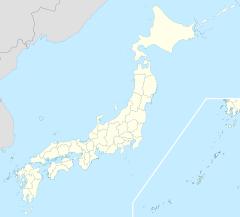JY18 JB11 E26 Yoyogi Station 代々木駅 | ||||||||||||||||||||||||||
|---|---|---|---|---|---|---|---|---|---|---|---|---|---|---|---|---|---|---|---|---|---|---|---|---|---|---|
 The main (west) entrance in July 2012 | ||||||||||||||||||||||||||
| Location | 1 Yoyogi, Shibuya-ku, Tokyo Japan | |||||||||||||||||||||||||
| Operated by | ||||||||||||||||||||||||||
| Line(s) |
| |||||||||||||||||||||||||
| Other information | ||||||||||||||||||||||||||
| Station code |
| |||||||||||||||||||||||||
| History | ||||||||||||||||||||||||||
| Opened | 23 October 1906 | |||||||||||||||||||||||||
| Services | ||||||||||||||||||||||||||
| ||||||||||||||||||||||||||
| Location | ||||||||||||||||||||||||||
Yoyogi Station (代々木駅, Yoyogi-eki) is a railway station in Shibuya, Tokyo, Japan, operated by the East Japan Railway Company (JR East) and Tokyo Metropolitan Bureau of Transportation (Toei). It is station E-26 under Toei's numbering system.
Station layout
JR East
The JR East station consists of two ground-level side platforms on either side of an island platform, serving four tracks in total.
| 1 | JY Yamanote Line | for Shinjuku and Ikebukuro |
| 2 | JY Yamanote Line | for Shibuya and Shinagawa |
| 3 | JB Chūō-Sōbu Line | for Shinjuku, Nakano, and Mitaka |
| 4 | JB Chūō-Sōbu Line | for Ochanomizu, Akihabara, Funabashi, and Chiba |
Chest-high platform edge doors were installed on the Yamanote Line platforms in September 2015, and brought into use from October.[1]
There are three exits: East exit, West exit, and North exit. The latter two provide easy access to the Oedo line.
Toei
The Toei Oedo Line station has one underground island platform serving two tracks.
| 1 | E Toei Oedo Line | for Roppongi |
| 2 | E Toei Oedo Line | for Hikarigaoka |
History
The station first opened on 23 October 1906 by a private company as a station on the Chūō Main Line, but was nationalized only a week later when the Japanese National Railways (JNR) took over the company and all of its assessments. The underground Toei Ōedo Line station opened on 20 April 2000.[2]
Passenger statistics
In fiscal 2013, the JR East station was used by an average of 70,016 passengers daily (boarding passengers only), making it the 63rd-busiest station operated by JR East.[3] In fiscal 2013, the Toei station was used by an average of 17,382 passengers daily (boarding passengers only).[4] The daily average passenger figures (boarding passengers only) for JR East in previous years are as shown below.
| Fiscal year | Daily average |
|---|---|
| 2000 | 55,062[5] |
| 2005 | 68,471[6] |
| 2010 | 69,704[7] |
| 2011 | 69,466[8] |
| 2012 | 70,418[9] |
| 2013 | 70,016[3] |
See also
References
- ^ 山手線代々木駅に可動式ホーム柵が設置される [Platform edge doors installed on Yoyogi Station Yamanote Line platforms]. Japan Railfan Magazine Online (in Japanese). Japan: Koyusha Co., Ltd. 26 September 2015. Retrieved 27 September 2015.
- ^ Terada, Hirokazu (July 2002). データブック日本の私鉄 [Databook: Japan's Private Railways]. Japan: Neko Publishing. ISBN 4-87366-874-3.
- ^ a b 各駅の乗車人員 (2013年度) [Station passenger figures (Fiscal 2013)] (in Japanese). Japan: East Japan Railway Company. Retrieved 24 January 2015.
- ^ 各駅乗降人員一覧 [Station usage figures] (in Japanese). Tokyo Metropolitan Bureau of Transportation. Retrieved 24 January 2015.
- ^ 各駅の乗車人員 (2000年度) [Station passenger figures (Fiscal 2000)] (in Japanese). Japan: East Japan Railway Company. Retrieved 24 January 2015.
- ^ 各駅の乗車人員 (2005年度) [Station passenger figures (Fiscal 2005)] (in Japanese). Japan: East Japan Railway Company. Retrieved 24 January 2015.
- ^ 各駅の乗車人員 (2010年度) [Station passenger figures (Fiscal 2010)] (in Japanese). Japan: East Japan Railway Company. Retrieved 24 January 2015.
- ^ 各駅の乗車人員 (2011年度) [Station passenger figures (Fiscal 2011)] (in Japanese). Japan: East Japan Railway Company. Retrieved 24 January 2015.
- ^ 各駅の乗車人員 (2012年度) [Station passenger figures (Fiscal 2012)] (in Japanese). Japan: East Japan Railway Company. Retrieved 24 January 2015.
External links
- JR East station information (in Japanese)
- Toei station information (in Japanese)








